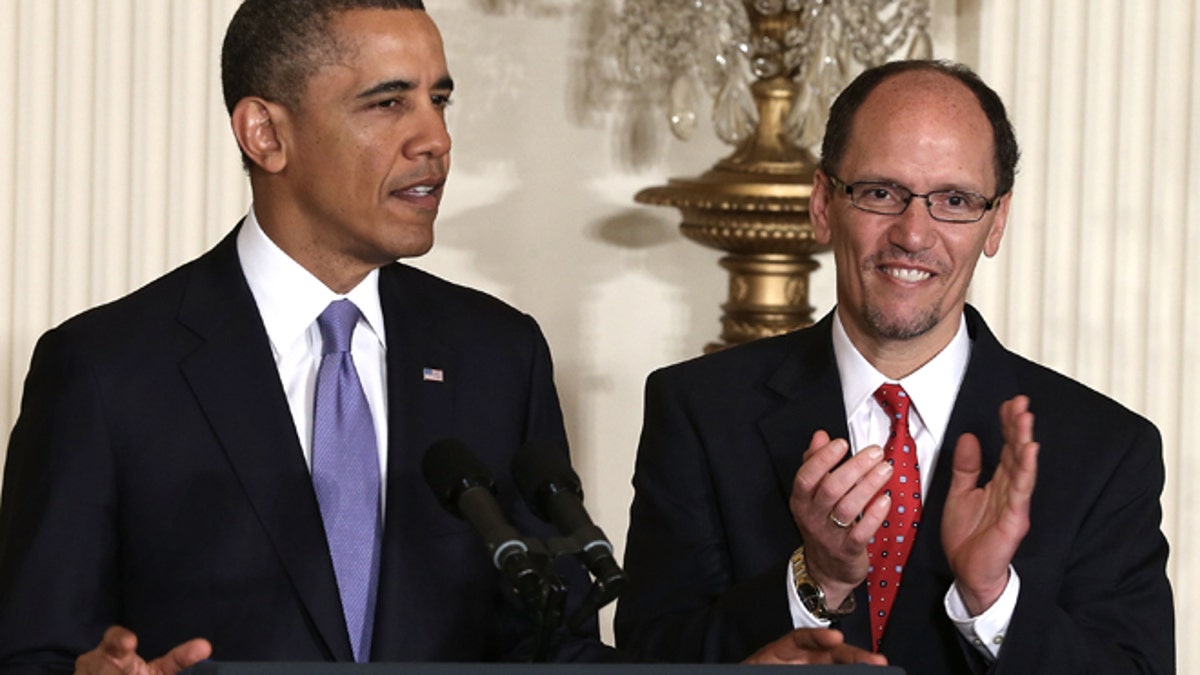
WASHINGTON, DC - MARCH 18: U.S. President Barack Obama (L) speaks as Assistant Attorney General of Justice Department's civil rights division Thomas Perez (R) listens during a personnel announcement March 18, 2013 at the East Room of the White House in Washington, DC. President Obama has nominated Perez to succeed Hilda Solis as the next labor secretary. (Photo by Alex Wong/Getty Images) (2013 Getty Images)
When Tom Perez was confirmed by the Senate Thursday as the only Hispanic at the Cabinet Secretary level for the President’s second term, it brought our nation a little closer to the ideals on which it was founded. After all, you can’t have a government of, by and for the people without reflecting the nation’s diversity.
When President Obama took office in 2009, he understood that. At its first term peak, the Obama administration boasted more than 30 Hispanics at every level in the White House, and 10 percent of appointments that required Senate confirmation were Hispanic. Historic nominations like Sonia Sotomayor’s to the Supreme Court made that record even stronger. Still, the administration hasn’t been able to keep up that pace, and the Perez confirmation was a reminder that more needs to be done.
Perspective from different backgrounds enriches debate inside government meetings. Just imagine if everyone making policy decisions on rural issues had never lived outside a big city.
Hispanics number more than 50 million and according to the Labor Department represented 15 percent of the nation's workforce in 2010, a number expected to rise to 18 percent by 2018. Yet when it comes to Hispanic representation in the federal government, the numbers have never come close.
According to the Office of Personnel Management, the number of Hispanics in the civilian workforce has hovered around 8 percent for several years. For political appointments each administration makes, the numbers aren’t available now, and the truth is that it is unlikely the number of Hispanics in positions requiring Senate confirmation are anywhere near their high point.
Diversity matters. Perspective from different communities and backgrounds enriches debate inside government meetings. Just imagine if everyone making policy decisions on rural issues had never lived outside a big city. Or take a step back and envision a government in which only men decide what women can do with regard to their own health care. Even in our courts, where the law must be applied even handedly, diversity adds value.
On the third day of her confirmation hearings in 2009, Justice Sotomayor told a story about a letter she received when she was nominated to the circuit court. In the letter, a woman who had 19 daughters and grandchildren wrote to let her know how much pride she took in knowing another woman could serve on a court like the 2nd Circuit. Sotomayor said that it made her realize “how important the diversity of the bench is to making people feel and understand the great opportunity America provides to all its citizens.”
To be clear, Sotomayor and Perez are examples that diversity is not inconsistent with excellence. Both have proven to be fine public servants regardless of their background, and possess the skills, temperament, and commitment to serve that we should want of every government official.
But the Tom Perez example also holds another lesson. He was promoted from within after proving himself at the Department of Justice as an effective and strong leader in the Civil Rights Division. That’s the right approach for growing a bench that’s deeper, stronger, and can reach higher when positions become available. But Perez is the exception, not the norm. If the administration misses the opportunity to promote from the ranks of those who have already begun serving in the first term, the natural departure of appointees that takes place at this point of any presidency will become problematic.
The President started on the right foot four years ago, and OPM should be credited for their initiatives to boost diversity among the federal workforce. However, the administration should be transparent about how that record is evolving, and tap into talent that’s already there and ready to move to the next level. That kind of approach would not only help this administration, it would help the next.
